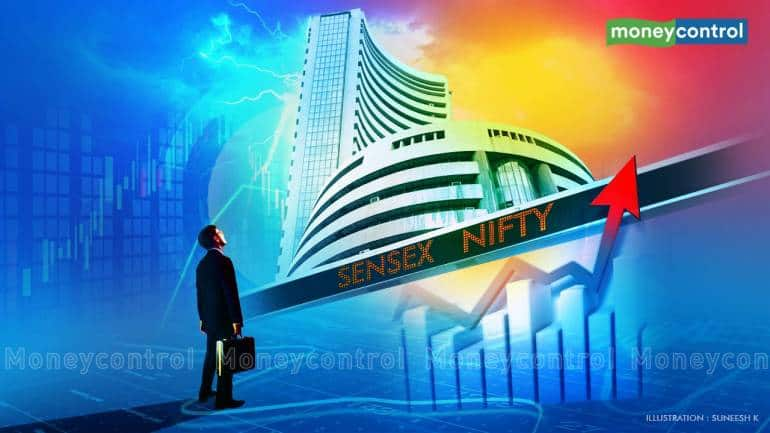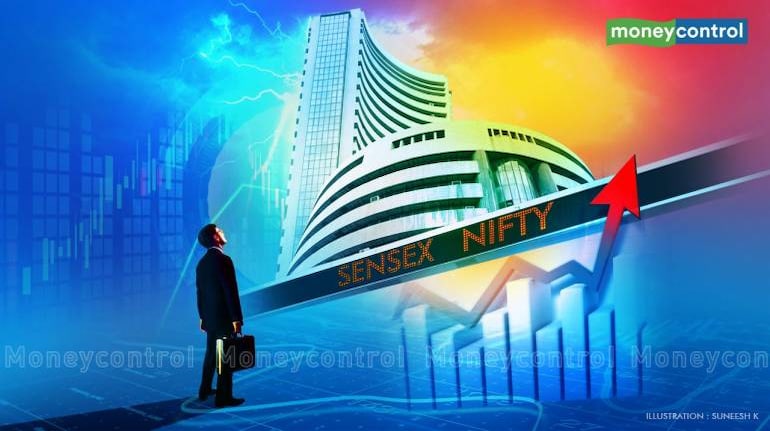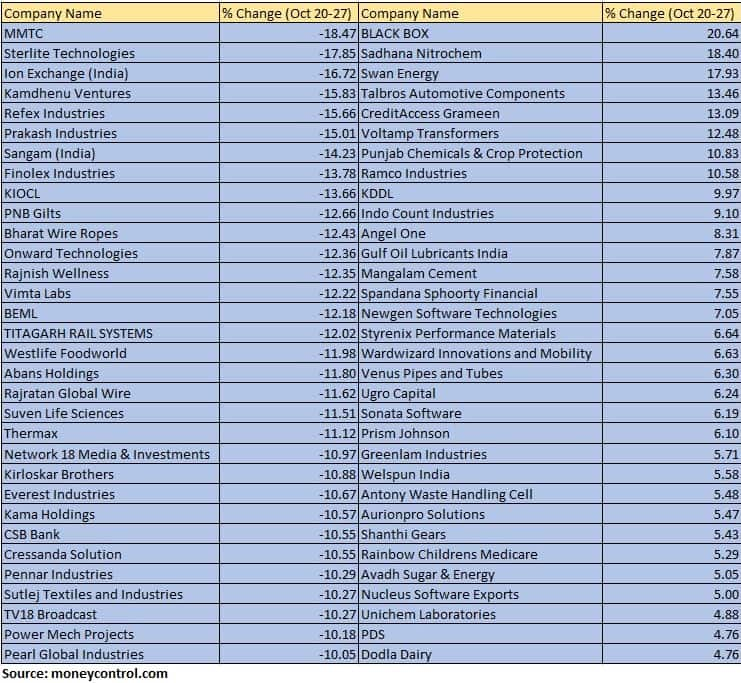These smallcaps deliver in double digits despite strong negative cues weighing on markets


The evolving US markets and the geopolitical crisis will continue to hold sway over the global markets in the coming days too.
From the simmering Middle East to boiling bold yields in the US, and the chill sent out by sustained exodus of foreign institutions and rate hike worries amid lukewarm corporate earnings – a host of factors seem to have orchestrated a 2.5 percent decline in the Indian markets at close on October 27.
The BSE Sensex fell 2.46 percent or 1,614.82 points to finish at 63,782.80, while Nifty50 declined 495.35 points or 2.53 percent to 19,047.30. Broader indices performed in-line with the main indices as BSE Small-cap, BSE Mid-cap and Large-cap indices shed 3.4 percent, 2.4 percent and 2.5 percent, respectively.
“In the past week, the Nifty and the Sensex both declined by approximately 2.5 percent, ranking among the top losers in global equity markets. Smaller companies fared worse, with the Nifty Midcap down 3 percent and the BSE Smallcap down 2 percent,” says Shrikant Chouhan, head of equity research (retail) at Kotak Securities.
Factors contributing to this downturn included higher global interest rates, growth concerns, and lacklustre Q2FY24 earnings. All sectoral indices also saw losses, with Nifty Realty, Nifty Metals, and Media hit hardest. Notable Nifty gainers were Axis Bank, Coal India, and HCL Tech, while UPL, Adani Enterprises, and JSW Steel faced significant losses.
“Foreign Portfolio Investors (FPIs) continued to sell, mirroring the trend in emerging markets, while Domestic Institutional Investors (DIIs) remained net buyers. On the global front, the US GDP growth of 4.9 percent in Q3 is attributed to consumer spending, exports, and government spending. The European Central Bank held the interest rates unchanged, ending a streak of 10 consecutive increases due to Eurozone growth concerns,” Chouhan said.
On the sectoral front, all the indices ended in the red with the Nifty Media index down 5.3 percent, Nifty Metal index 4 percent, and Nifty Information Technology, Nifty Oil & Gas and Nifty Realty indices down 3 percent each.
In this week, Foreign institutional investors (FIIs) stepped on the gas, selling off equities worth Rs 13,187.01 crore. Domestic institutional investors (DIIs), however, compensated pumping in Rs 11,553.34 crore. In October, the FIIs sold equities worth Rs 26,598.73 crore and DIIs purchased equities worth Rs 23,437.14 crore.
“After a drastic fall in the indices over the last few trading sessions, the major indices climbed over 1 percent on the last trading day of the week. The fall was caused by a fall in the US markets and the aggravation of the Middle East conflict. There are strong indication that the US rates may move up further, owing to elevated inflation levels,” said Joseph Thomas, head of research at Emkay Wealth Management.
The evolving US markets and the geopolitical crisis will continue to hold sway over the global markets in the coming days too. The domestic economy is afforded some protection by robust economic growth and the strong fundamentals. “Another factor that adds to the positivity is the likelihood of domestic interest rates remaining stable for a longer time after the recent spike in money market yields,” he said.
The BSE Smallcap index declined 3.4 percent, dragged by MMTC, Sterlite Technologies, Ion Exchange (India), Kamdhenu Ventures, Refex Industries, Prakash Industries, Sangam (India), Finolex Industries, KIOCL, PNB Gilts and Bharat Wire Ropes.

Black Box, Sadhana Nitrochem, Swan Energy, Talbros Automotive Components, CreditAccess Grameen, Voltamp Transformers, Punjab Chemicals & Crop Protection and Ramco Industries added 10-20 percent.
But, where is the Nifty50 headed from here on? Let’s check out what experts say.
Jatin Gedia – Technical Research Analyst at Sharekhan by BNP Paribas
On the weekly charts, the Nifty has respected the support zone of 18,800 – 18,925 where multiple support parameters in the form of the 40-week average and a crucial Fibonacci retracement level was placed. Thus, going ahead, the Nifty can consolidate within 18,800 – 19,200 before resuming the next leg of the fall. In terms of levels, 19,160 – 19,220 shall act as a resistance, while 18,930 – 18,900 shall act as an immediate support zone.
Rupak De, Senior Technical Analyst at LKP Securities
After relentless selling in recent days, the Nifty has temporarily paused its decline due to an oversold chart setup. However, the index closed significantly below the critical breakdown level of 19,250. As long as it stays below 19,250, the market may continue to be inclined towards selling on any upward movements.
On the downside, a resumption of weakness is expected if the index falls below 18,800. This is because put writers are likely to defend the Nifty with substantial positions at 18800, with immediate support placed at 19000.
Amol Athawale, Vice President – Technical Research, Kotak Securities
The lingering negative factors such as Israel-Hamas conflict, surging US bond yield, FII fund outflows, and rate hike worries will mean markets are likely to stay volatile going ahead.
Technically, on weekly charts the Nifty has formed a long bearish candle, indicating strong possibility of further weakness from the current levels. As long as the index is trading above 18,900, the pullback rally is likely to continue till 19,200-19,275.
On the flip side, below 18,900, the selling pressure is likely to accelerate and could slip till 18,800. Further down side may drag the index till 18700.
Disclaimer: The views and investment tips expressed by experts on Moneycontrol.com are their own and not those of the website or its management. Moneycontrol.com advises users to check with certified experts before taking any investment decisions.

